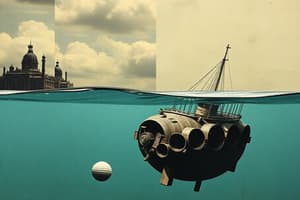Podcast
Questions and Answers
What is buoyancy?
What is buoyancy?
- A downward force exerted by a fluid
- A force exerted by a solid object in a fluid
- A force exerted horizontally by a fluid
- An upward force exerted by a fluid (correct)
How does pressure change with depth in a column of fluid?
How does pressure change with depth in a column of fluid?
- Pressure increases with depth (correct)
- Pressure decreases with depth
- Pressure is unrelated to depth
- Pressure remains constant with depth
What does Archimedes' principle explain?
What does Archimedes' principle explain?
- The relationship between pressure and depth
- The displacement of fluid by an immersed object (correct)
- The magnitude of the force of buoyancy
- The behavior of light in fluids
In which direction does the net force act on an object submerged in a fluid?
In which direction does the net force act on an object submerged in a fluid?
What happens to an object with average density greater than the fluid it's submerged in?
What happens to an object with average density greater than the fluid it's submerged in?
What is the upward force exerted by a fluid that opposes the weight of a partially or fully immersed object called?
What is the upward force exerted by a fluid that opposes the weight of a partially or fully immersed object called?
In a column of fluid, how does pressure change with depth?
In a column of fluid, how does pressure change with depth?
What is the magnitude of the buoyant force proportional to?
What is the magnitude of the buoyant force proportional to?
According to Archimedes' principle, what is the buoyant force equivalent to?
According to Archimedes' principle, what is the buoyant force equivalent to?
What happens to an object with average density greater than that of the fluid in which it's submerged?
What happens to an object with average density greater than that of the fluid in which it's submerged?
Flashcards are hidden until you start studying
Study Notes
Buoyancy and Fluid Dynamics
- Buoyancy refers to the ability of an object to float or rise when submerged in a fluid due to the upward force exerted by the fluid.
- Pressure increases with depth in a fluid column because the weight of the fluid above exerts force on the fluid below, resulting in higher pressure at greater depths.
Archimedes' Principle
- Archimedes' principle states that any object submerged in a fluid experiences a buoyant force equal to the weight of the fluid displaced by the object, explaining why objects float or sink.
Direction of Forces
- The net force on an object submerged in a fluid acts upward, opposing the weight of the object, which can lead to floating or submersion.
Effects of Density
- An object with an average density greater than the surrounding fluid will sink, as the buoyant force is insufficient to counteract its weight.
Upward Force in Fluids
- The upward force exerted by a fluid that opposes the weight of a partially or fully immersed object is known as the buoyant force.
Relationship of Pressure and Depth
- In a fluid column, pressure changes linearly with depth, increasing proportionally to the height of the fluid column above.
Magnitude of Buoyant Force
- The magnitude of the buoyant force is proportional to the volume of fluid displaced by the submerged object.
Buoyant Force Equivalence
- According to Archimedes' principle, the buoyant force on an object is equivalent to the weight of the fluid displaced by that object.
Consequences of High Density
- An object with an average density greater than that of the fluid will sink, indicating it cannot displace a sufficient volume of fluid to achieve buoyancy.
Studying That Suits You
Use AI to generate personalized quizzes and flashcards to suit your learning preferences.




